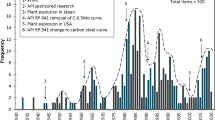Abstract
In this work, electrochemical corrosion behavior of a welded X100 pipeline steel was studied in a near-neutral pH solution by electrochemical scanning vibrating electrode technique combined with metallographic and scanning electron microscopy/energy dispersive x-ray analysis. Results demonstrated that a softening phenomenon occurs around the weld, and there is the high micro-hardness in base steel adjacent to weld. In particular, there is the highest micro-hardness in base steel containing acicular ferrite and bainite. Therefore, welding and the associated post-treatment on X100 steel alter dramatically the microstructure and mechanical property around weld, resulting in an enhanced micro-hardness in base steel. There are high and low local dissolution current densities at base steel and the welded zones, respectively. The difference between the maximum and minimum dissolution current densities decreases with time, and the distribution of dissolution current density tends to be uniform. Hydrogen-charging changes the local dissolution activity of the welded steel. Different from the hydrogen-free steel, there is the highest dissolution current density at heat-affected zone. It is reasonable to assume that the charged hydrogen would accumulate at heat-affected zone, and the synergism of hydrogen and local stress results in a high anodic dissolution rate.










Similar content being viewed by others
References
K.T. Corbett, R.R. Bowen, and C.W. Petersen, High Strength Steel Pipeline Economics, Int. J. Offshore Pol. Eng., 2004, 14, p 75–79
F.J. Sánchez, B. Mishra, and D.L. Olson, Magnetization Effect on Hydrogen Absorption in High-Strength Steels and Its Implications, Scr. Mater., 2005, 53, p 1443–1448
D. Porter, A. Laukkanen, P. Nevasmaa, K. Rahka, and K. Wallin, Performance of TMCP Steel with Respect to Mechanical Properties After Cold Forming and Post-Forming Heat Treatment, Int. J. Press. Vess. Pip., 2004, 81, p 867–877
H.E. Minor, A. Kifani, M. Louah, Z. Azari, and G. Pluvinage, Fracture Toughness of High Strength Steel—Using the Notch Stress Intensity Factor and Volumetric Approach, Struct. Saf., 2003, 25, p 35–45
Y.Z. Wang, R.W. Revie, M.T. Shehata, R.N. Parkins, and K. Krist, Initiation of Environment Induced Cracking in Pipeline Steel: Micro-Structural Correlation, International Pipeline Conference, ASME, Calgary, 1998
M. Baker Jr., Stress Corrosion Cracking Studies, Integrity Management Program DTRS56-02-D-70036, Department of Transportation, Office and Pipeline Safety, 2004
National Energy Board, Report of Public Inquiry Concerning Stress Corrosion Cracking on Canadian Oil and Gas Pipelines, MH-2-95, November 1996
S.J. Kim, M. Okido, and K.M. Moon, The Effect of Postweld Heat Treatment Affecting Corrosion Resistance and Hydrogen Embrittlement of HAZ Part in FCAW, Surf. Coat. Technol., 2003, 169/170, p 675–679
K.M. Moon, M.H. Lee, K.J. Kim, and S.J. Kim, Influence of Interlayers on Corrosion Resistance of Ion-Plated Mg Thin Films, Surf. Coat. Technol., 2008, 202, p 5603–5606
T. Hemmingsen, H. Hovdan, P. Sanni, and N.O. Aagotnes, The Influence of Electrolyte Reduction Potential on Weld Corrosion, Electrochim. Acta, 2002, 47, p 3949–3955
W. Zhang, J.W. Elmer, and T. DebRoy, Modeling and Real Time Mapping of Phases During gta Welding of 1005 Steel, Mater. Sci. Eng. A, 2002, 333, p 320–335
X. Tang and Y.F. Cheng, Micro-Electrochemical Characterization of the Effect of Applied Stress on Local Anodic Dissolution Behavior of Pipeline Steel Under Near-Neutral pH Condition, Electrochim. Acta, 2009, 54, p 1499–1505
G.Z. Meng, C. Zhang, and Y.F. Cheng, Effects of Corrosion Product Deposit on the Subsequent Cathodic and Anodic Reactions of X-70 Steel in Near-Neutral pH Solution, Corros. Sci., 2008, 50, p 3116–3122
C.F. Dong, A.Q. Fu, X.G. Li, and Y.F. Cheng, Localized EIS Characterization of Corrosion of Steel at Coating Defect Under Cathodic Protection, Electrochim. Acta, 2008, 54, p 628–633
R.N. Parkins, A Review of Stress Corrosion Cracking of High Pressure Gas Pipelines, Corrosion 2000, NACE, Houston, 2000, paper no. 363
L. Niu and Y.F. Cheng, Corrosion Behaviour of X-70 pipe Steel in Near-Neutral pH Solution, Appl. Surf. Sci., 2007, 253, p 8626–8631
Y.F. Cheng and L. Niu, Mechanism for Hydrogen Evolution Reaction on Pipeline Steel in Near-Neutral pH Solution, Electrochem. Commun., 2007, 9, p 558–562
C.W. Du, X.G. Li, P. Liang, Z.Y. Liu, G.F. Jia, and Y.F. Cheng, Effects of Microstructure on Corrosion of X70 Pipe Steel in an Alkaline Soil, J. Mater. Eng. Perform., 2009, 18, p 216–220
J. Brozda and M. Zeman, Wrong Heat Treatment of Martensite Steel Welded Tubes, Eng. Fail. Anal., 2003, 10, p 569–579
Z.Y. Liu, X.G. Li, C.W. Du, L. Lu, Y.R. Zhang, and Y.F. Cheng, Effect of inclusions on Initiation of Stress Corrosion Cracks in X70 Pipeline Steel in an Acidic Soil Environment, Corros. Sci., 2009, 51, p 895–900
E. Barsoukov and J.R. Macdonald, Impedance Spectroscopy Theory, Experiment, and Applications, Wiley, New Jersey, 2005
M.C. Li and Y.F. Cheng, Mechanistic Investigation of Hydrogen-Enhanced Anodic Dissolution of X-70 Pipe Steel and Its Implication on Near-Neutral pH SCC of Pipelines, Electrochim. Acta, 2007, 52, p 8111–8117
H.J. Zhang, G.J. Zhang, C.B. Cai, H.M. Gao, and L. Wu, Numerical Simulation of Three-Dimension Stress Field in Double-Sided Double Arc Multipass Welding Process, Mater. Sci. Eng. A, 2009, 499, p 309–314
R.A. Oriani, J.P. Hirth, and M. Smialowski, Hydrogen Degradation of Ferrous Alloys, Noyes Publications, Park Ridge, NJ, 1985
Acknowledgments
This work was supported by Canada Research Chairs Program, Chinese Scholarship Council (CSC) and Natural Science Foundation of China (Project no. 50671007 and no. 50731003).
Author information
Authors and Affiliations
Corresponding author
Rights and permissions
About this article
Cite this article
Zhang, C., Cheng, Y.F. Corrosion of Welded X100 Pipeline Steel in a Near-Neutral pH Solution. J. of Materi Eng and Perform 19, 834–840 (2010). https://doi.org/10.1007/s11665-009-9580-x
Received:
Revised:
Published:
Issue Date:
DOI: https://doi.org/10.1007/s11665-009-9580-x




